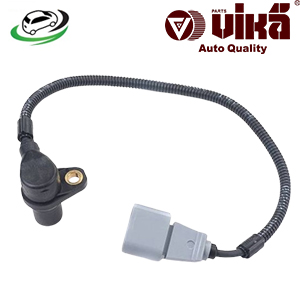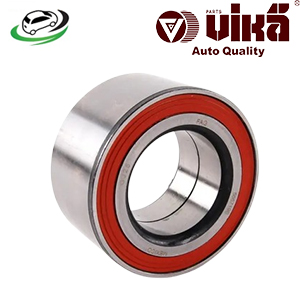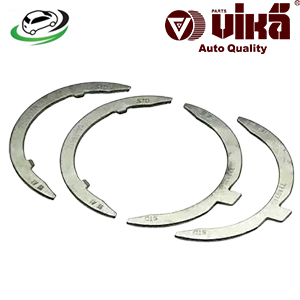-15%
Get Thrust Washer Audi A3 10-2016/ Audi A4 97-2006/ Audi TT 00-2002 26198421
A thrust washer is a critical component in mechanical assemblies, used primarily to manage axial loads and reduce friction between moving parts. While simple in appearance, thrust washers play a vital role in ensuring the smooth operation, longevity, and reliability of various mechanical systems, including automotive engines, transmissions, and industrial machinery. This comprehensive exploration will cover the function, construction, types, applications, issues, and importance of thrust washers, offering a deep understanding of this essential mechanical element.
Function of a Thrust Washer
- Axial Load Management:
- Thrust washers are specifically designed to handle axial loads, which are forces acting parallel to the axis of rotation. These loads can push rotating components along the shaft, potentially leading to misalignment or excessive wear. The thrust washer absorbs and distributes these forces, preventing unwanted movement and maintaining the integrity of the assembly.
- Friction Reduction:
- Thrust washers provide a smooth, low-friction surface between rotating parts, such as gears, shafts, or bearings. This reduces wear on these components, enhancing their durability and performance. By minimizing friction, thrust washers also contribute to the efficiency of the system, reducing energy losses and operational noise.
- Space Adjustment:
- In many mechanical systems, precise spacing between components is crucial for proper operation. Thrust washers, available in various thicknesses, allow engineers to fine-tune the distance between parts, ensuring correct alignment and operation. This feature is particularly important in complex assemblies where tight tolerances are required.
- Vibration Dampening:
- In addition to managing axial loads and reducing friction, thrust washers can dampen vibrations between moving parts. This not only reduces noise but also protects components from damage caused by continuous vibration, thereby extending the lifespan of the entire assembly.
Construction of a Thrust Washer
- Materials:
- Metals: Thrust washers are commonly made from durable metals such as steel, bronze, or brass. These materials offer excellent strength, wear resistance, and the ability to withstand high loads and temperatures.
- Composites: In some applications, composite materials like PTFE (polytetrafluoroethylene) or other polymers are used. These materials provide low friction and self-lubricating properties, making them ideal for applications where lubrication is challenging or where metal-to-metal contact is undesirable.
- Bimetallic Designs: Certain thrust washers are constructed using a combination of materials, such as a steel backing with a softer, low-friction alloy surface. This design leverages the strength of steel while providing a surface that minimizes wear and friction.
- Design:
- Plain Thrust Washers: The most basic design is a flat, circular washer with a central hole that fits around a shaft. These washers are straightforward in design but highly effective in managing axial loads and reducing friction.
- Grooved Thrust Washers: To improve lubrication distribution and reduce friction further, some thrust washers feature grooves or patterns on their surface. These grooves help to spread lubricant evenly, enhancing performance, especially in high-speed applications.
- Flanged Thrust Washers: These washers have an extended lip or flange on their outer edge, providing additional surface area for load distribution and helping to keep the washer in place during operation.
- Dimensions:
- Inner and Outer Diameter: The size of a thrust washer is defined by its inner and outer diameters, which correspond to the shaft size and the space between components, respectively. Proper sizing is crucial for ensuring effective load management and component alignment.
- Thickness: The thickness of the thrust washer determines the gap between components, influencing the washer’s ability to handle axial loads and maintain the correct spacing.
Types of Thrust Washers
- Plain Thrust Washers:
- These are simple, flat washers made from various materials, including metal and composite. They are commonly used in applications with moderate loads and where space is limited.
- Grooved Thrust Washers:
- Designed with surface grooves, these washers improve lubricant distribution and cooling, making them suitable for high-load or high-speed applications where heat and friction are concerns.
- Flanged Thrust Washers:
- Featuring an extended lip or flange, these washers offer additional load-bearing capacity and help maintain the alignment of components in more complex assemblies.
- Bimetallic Thrust Washers:
- These washers combine a strong backing material with a softer, low-friction surface. They are ideal for applications requiring both durability and minimal friction, such as in automotive engines and heavy machinery.
- Self-Lubricating Thrust Washers:
- Made from materials like PTFE or impregnated with lubricants, these washers operate efficiently in environments where regular lubrication is not possible, reducing maintenance needs and improving reliability.
Applications of Thrust Washers
- Automotive Engines:
- In automotive engines, thrust washers are commonly used in crankshaft assemblies to control axial movement and reduce wear. They help maintain proper alignment and ensure smooth engine operation by minimizing friction between rotating components.
- Transmissions:
- In both manual and automatic transmissions, thrust washers support gears and shafts, preventing axial movement and reducing friction. This contributes to smoother gear shifts and extends the life of transmission components.
- Industrial Machinery:
- Thrust washers are widely used in industrial machinery, including pumps, compressors, and gearboxes, to support rotating components, reduce wear, and improve efficiency.
- Marine and Aerospace Applications:
- In marine and aerospace propulsion systems, thrust washers handle axial loads and reduce wear on critical components, ensuring reliable and efficient operation in challenging environments.
- Consumer Products:
- Thrust washers are also found in household appliances, power tools, and other consumer products where they reduce friction and extend the life of moving parts.
Common Issues with Thrust Washers
- Wear and Tear:
- Over time, thrust washers can wear down due to continuous friction and load-bearing. This wear can lead to increased axial movement, reduced efficiency, and potential failure of the mechanical assembly.
- Improper Installation:
- Incorrect installation can result in misalignment, uneven wear, or inadequate load distribution, all of which can compromise the performance and longevity of the thrust washer and surrounding components.
- Contamination:
- Exposure to dirt, debris, or corrosive substances can damage the surface of thrust washers, leading to accelerated wear and potential failure. In environments where contamination is a concern, proper sealing and regular maintenance are essential.
- Overloading:
- Thrust washers are designed to handle specific axial loads. Exceeding these limits can cause deformation, excessive wear, and eventual failure. Proper load calculation and material selection are crucial for preventing overloading issues.
Importance of Thrust Washers
Thrust washers are indispensable in many mechanical systems, offering several key benefits:
- Reliability:
- By effectively managing axial loads and reducing friction, thrust washers help prevent mechanical failures, ensuring the reliable operation of engines, transmissions, and other assemblies.
- Efficiency:
- Thrust washers contribute to the overall efficiency of mechanical systems by minimizing friction and wear, reducing energy consumption, and lowering operating costs.
- Longevity:
- By protecting critical components from wear and maintaining proper alignment, thrust washers extend the lifespan of mechanical systems, reducing the need for repairs and replacements.
Follow us on Facebook for more parts.



